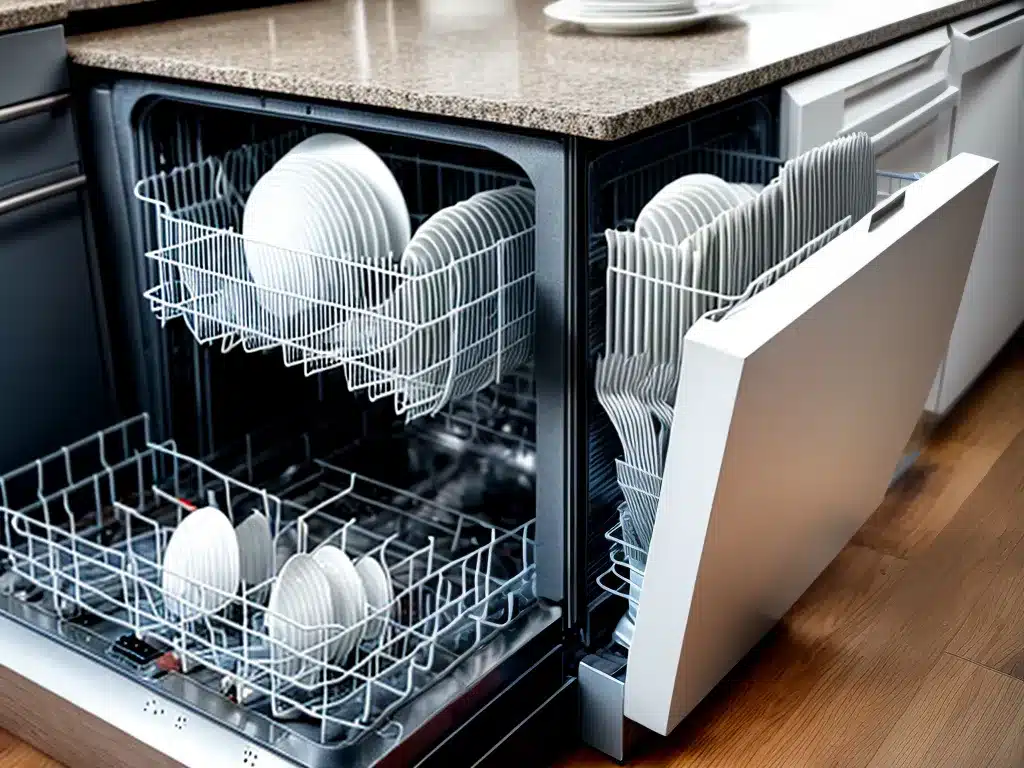
Symptoms of a Faulty Dishwasher
When experiencing issues with your dishwasher, the first step is identifying the specific problem based on common symptoms. Here are some signs that your dishwasher may be faulty:
Dishes Not Cleaning Properly
- Dishes are coming out with food residue or film still on them.
- Dishes feel greasy after washing.
- Glasses and flatware have cloudy, streaky residue.
- The main causes are:
- Not enough detergent – Check that you are using the recommended amount.
- Clogged spray arms – Food and grease can clog the spray arms.
- Hard water buildup – Mineral deposits from hard water reduce cleaning.
- Dirty filter – A clogged filter prevents proper water circulation.
Leaking Water
- Water leaks out the bottom front of the dishwasher door.
- Small puddles of water around the machine after a cycle.
- The cause is usually a worn or faulty door seal.
Unusual Noises
- Grinding, buzzing or whining noises during a cycle.
- Banging noises, like something is loose inside.
- This indicates an issue with the motor, pump, or internal components.
Won’t Start, Doesn’t Fill, or Stops Mid-Cycle
- Dishwasher won’t start at all or stops during a cycle.
- Machine doesn’t fill with water.
- Causes include:
- Faulty control board
- Bad door latch switch
- Failed motor
- Clogged or kinked intake hose
- Tripped circuit breaker
Diagnosing the Specific Problem
Once you’ve identified the type of issue based on the symptoms, you can narrow down the parts or systems potentially causing the problem. Here are diagnostic steps for common dishwasher issues:
Dishes Not Cleaning Properly
- Confirm detergent amount, unblock spray arms, and run appliance cleaner cycle.
- Check water temperature – should be 120-140°F. If low, inspect heating element.
- Test water pressure coming into the dishwasher.
- Remove and clean the filter if clogged with debris.
- Run a rinse cycle and inspect spray arm rotation and water flow.
Leaking
- Check door seal for cracks or tears. Replace seal if worn out.
- Confirm detergent dispenser door seals properly and fully latches.
- Examine intake hose connection under the sink for leaks.
- Tighten hose clamps if loose. Replace any hoses that are swollen.
Unusual Noises
- Listen closely to identify where sound is coming from – pump, motor, bottom, etc.
- Check pump and filter for blockages.
- Test the motor. Replace if seized up or worn out.
- Inspect spray arms, mountings, and internal components. Tighten or replace as needed.
Won’t Start, Doesn’t Fill, or Stops Mid-Cycle
- Verify power supply and check circuit breaker or fuses.
- Test voltage to dishwasher using a multimeter.
- Press door firmly to ensure latch switch makes secure contact.
- Check control board for any error codes. Replace if faulty.
- Inspect and clean door latch switch. Replace if worn out.
- Confirm water intake hose is not kinked. Check fill valve and inlet blockage.
- Drain pump issues – test and replace if faulty.
Replacing Dishwasher Parts
If you’ve diagnosed which part is faulty, you may need to replace dishwasher components. Here are some tips for this:
- Disconnect power to unit before repairs for safety.
- Review repair/replacement instructions for your model.
- Check door seal – lift upward firmly to remove adhesive strip and replace.
- Remove outer door panel screws to access control panel.
- Detach the old part and plug in the new one.
- Use locking pliers to hold spray arm in place when removing or installing.
- Check for leaks and test operation after replacing inlet hose, valves, pump, etc.
Replacing major parts like the motor or control board may require removing the inner door panel or the dishwasher from under the counter. This is more complex and may call for a professional repair.
Preventative Maintenance
Regular care and maintenance helps avoid many dishwasher issues and optimize performance. Recommended tips:
- Clean spray arms monthly – clear blocked holes under running water.
- Inspect and replace seals if worn. Use food-grade silicone lubricant on seals.
- Clean door latch contacts with electrical contact cleaner spray.
- Check and clean the filter every 1-2 months.
- Use a dishwasher cleaner monthly to remove grease and hard water buildup.
- Confirm adequate water pressure and temperature.
- Don’t overpack dishes – ensure proper water coverage.
Following the troubleshooting steps, diagnosing the issue, and properly replacing any faulty parts should resolve most common dishwasher problems. But if problems persist, don’t hesitate to call a technician.












